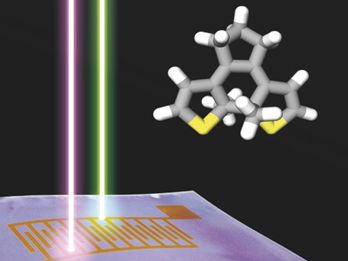Stefan Hecht, Humboldt University of Berlin, Germany, Emanuele Orgiu and Paolo Samorì, University of Strasbourg and CNRS, Strasbourg, France, and colleagues developed a light-responsive organic thin-film transistor. They blended a custom-designed molecule, a photochromic diarylethene, which serves as a miniaturized optical switch, with a high-performance semiconducting polymer, poly(3-hexylthiophene).
Illumination with ultraviolet and green light leads to a switch of the photochromic diarylethene. The molecule shows a reversible interconversion between two distinct forms. One form enables and the other one prevents current flowing through the surrounding semiconducting polymer. In other words, they fabricated a memory device that can be written and erased by light.
By integrating these components into transistor devices and using short laser pulses, the researchers were able to construct multilevel memories with a data storage capacity of 8 bits. Their prototype devices combine high endurance over 70 write-erase cycles and data retention times of over 500 days.
The team implemented the device on a flexible and light-weight polyethylene terephthalate substrate to replace the commonly used rigid silicon and to validate the concept for integration into wearable electronics and smart nanodevices. The researchers found that the “soft” architecture preserves its electrical characteristics after 1000 bending cycles.
According to the researchers, this approach has potential applications in flexible, high-density optical memory devices, logic circuits, and in the next generation of optoelectronics.
- Flexible non-volatile optical memory thin-film transistor device with over 256 distinct levels based on an organic bicomponent blend,
Tim Leydecker, Martin Herder, Egon Pavlica, Gvido Bratina, Stefan Hecht, Emanuele Orgiu, Paolo Samorì,
Nature Nanotechnol. 2016.
DOI: 10.1038/nnano.2016.87




